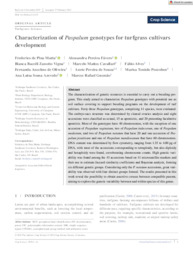Characterization of Paspalum genotypes for turfgrass cultivars development.
Characterization of Paspalum genotypes for turfgrass cultivars development.
Author(s): MATTA, F. de P.; FAVERO, A. P.; VIGNA, B. B. Z.; CAVALLARI, M. M.; ALVES, F.; OLIVEIRA, F. A. de; SOUZA, A. P. de; POZZOBON, M. T.; AZEVEDO, A. L. S.; GUSMAO, M. R.
Summary: The characterization of genetic resources is essential to carry out a breeding program. This study aimed to characterize Paspalum genotypes with potential use as soil surface covering to support breeding programs on the development of turf cultivars. Forty-three Paspalum genotypes, comprising 11 species, were evaluated. The embryo-sacs structure was determined by cleared ovaries analysis and eight accessions were classified as sexual, 15 as apomictic, and 20 presenting facultative apomixis. Most of the genotypes have 40 chromosomes, with the exception of one accession of Paspalum vaginatum, two of Paspalum indecorum, one of Paspalum modestum, and two of Paspalum notatum that have 20 and one accession of Paspalum jesuiticum and one of Paspalum mandiocanum that have 60 chromosomes. DNA content was determined by flow cytometry, ranging from 1.35 to 4.00 pg of DNA, with most of the accessions corresponding to tetraploidy, but also diploidy and hexaploidy were found, corroborating chromosome counts. High genetic variability was found among the 43 accessions based on 11 microsatellite markers and their use to estimate Jaccard similarity coefficients and Bayesian analysis, forming six different genetic groups. Considering only the P. notatum accessions, great variability was observed with four distinct groups formed. The results presented in this work reveal the possibility to obtain assertive crosses between compatible parents, aiming to explore the genetic variability between and within species of this genus.
Publication year: 2024
Types of publication: Journal article
Observation
Some of Embrapa's publications are published as ePub files. To read them, use or download one of the following free software options to your computer or mobile device. Android: Google Play Books; IOS: iBooks; Windows and Linux: Calibre.
Access other publications
Access the Agricultural Research Database (BDPA) to consult Embrapa's full library collection and records.
Visit Embrapa Bookstore to purchase books and other publications sold by Embrapa.

